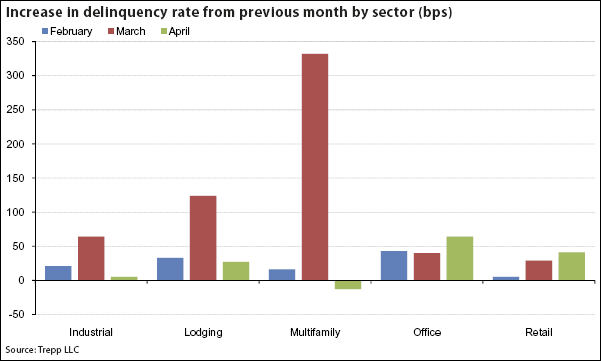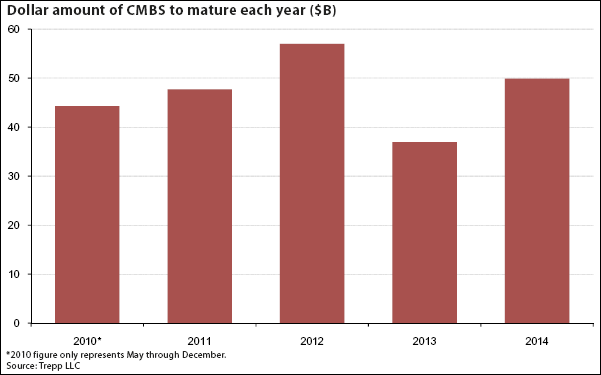Recent CMBS  delinquency
delinquency  reports have offered both hope to optimists who think the spikes in commercial real estate defaults might be nearing an end and fuel to pessimists who believe the worst is yet to come.
reports have offered both hope to optimists who think the spikes in commercial real estate defaults might be nearing an end and fuel to pessimists who believe the worst is yet to come.
The outlook depends on whether one takes comfort in the re-emergence of CMBS issuances and evidence of cap rate compression, or stockpiles fear from the troubling fundamentals of legacy CMBS assets.
"You have two real schools of thought right now," Manus Clancy, managing director of Trepp LLC, told SNL. "You have the school of thought which says it's going to get bad, bad, bad; [delinquency rates are] going to get into double digits, 12[%], 13[%]. And you have other people saying, 'You know, it's gotta start tapering off. It'll still keep going up, but the rate of increases is going to start tapering off.' I think you can go either way."
On the optimistic outlook, some argue that as pricing appears to be stabilizing or even increasing, the much-talked-about crush of commercial real estate foreclosures is unlikely. Essentially, the argument  goes, the commonly used "extend-and-pretend" characterization of high delinquency rates with few foreclosures fails to grasp the servicers' strategy: Prices are going up, so servicers are making the wise move to hold the asset until it recoups value rather than sell in a distressed market. Further, with new CMBS issuances showing up, property owners struggling to pay the bills might be able to refinance before defaulting.
goes, the commonly used "extend-and-pretend" characterization of high delinquency rates with few foreclosures fails to grasp the servicers' strategy: Prices are going up, so servicers are making the wise move to hold the asset until it recoups value rather than sell in a distressed market. Further, with new CMBS issuances showing up, property owners struggling to pay the bills might be able to refinance before defaulting.
In the other corner, pessimists point to deteriorating performance among legacy CMBS. And there is plenty of data supporting that argument. CMBS delinquencies have already hit 8.02%, according to Trepp. A separate delinquency-tracking firm, Realpoint, projects the average delinquency rate could hit 11.5% by year's end with the total delinquent unpaid balance breaching $90 billion. Also supporting the pessimists are weakening property fundamentals and looming maturity dates.
Which one do I look at?
Contributing to CMBS confusion is a variety of delinquency tracking data.
Trepp LLC's 8.02% delinquency rate in April is among the highest. Clancy said the firm's higher rate is largely attributable to the fact that it considers any default 30 days late as delinquent, compared to Moody's, which waits until 60 days late to term a loan delinquent.
Realpoint's most recent report showed a delinquency rate of 6.40%, lower than Moody's, Trepp or Fitch Ratings. But Realpoint's number is only from March, not April; further, it does not classify as delinquent the  loan behind Stuyvesant Town and Peter Cooper Village. Frank Innaurato, managing director of Realpoint, told SNL that both the lag in data and the exclusion of the Stuyvesant loan stem from Realpoint's tendency to use both bond-level and servicer-provided data to ensure a loan is actually in default. Further, Innaurato said, Realpoint includes agency loans, whereas Trepp does not, widening its coverage universe and potentially driving down its reported delinquency rate.
loan behind Stuyvesant Town and Peter Cooper Village. Frank Innaurato, managing director of Realpoint, told SNL that both the lag in data and the exclusion of the Stuyvesant loan stem from Realpoint's tendency to use both bond-level and servicer-provided data to ensure a loan is actually in default. Further, Innaurato said, Realpoint includes agency loans, whereas Trepp does not, widening its coverage universe and potentially driving down its reported delinquency rate.
We can't see clearly now
CMBS delinquencies have increased for several months in a row. Though that offers little solace, cycles typically show smaller increases on the way to a plateau before improving delinquency rates. The latest Trepp report offered a spark of hope that April might have marked the beginning of the end of rising CMBS delinquencies; April's increase of 41 basis points was less than half the 89-basis-point leap seen in March.
However, March's leap was largely  driven by the large Stuyvesant Town default, dampening hopes that increases might be slowing. Looking at a graph of increases by sector, Stuyvesant's effect on multifamily delinquencies is evident.
driven by the large Stuyvesant Town default, dampening hopes that increases might be slowing. Looking at a graph of increases by sector, Stuyvesant's effect on multifamily delinquencies is evident.

Also, larger April increases in office and retail further hurt expectations since the two sectors constitute an outsize portion of commercial real estate. In fact, Realpoint reported in its March data that retail accounted for the largest portion of CMBS delinquencies at 24.1% despite having a far smaller default rate than multifamily or hotel at 5.6%.
Questions of extrapolation
Still, the April increase in CMBS delinquencies moderated from March even without the Stuyvesant default. And Clancy said he thinks it could continue, largely because of improving confidence and new CMBS issuances.
"I was generally getting optimistic for the last two months, for a couple of reasons. You had spreads really compressing and cap rates as well, so that was really a positive sign," Clancy said. "You started seeing deals getting done, refinancings taking place and so forth. And then you started seeing things really get bid up on the equity side, you saw [General Growth Properties Inc.] get bid up."
Yet even Clancy unloads a heap of caveats with his prediction; chief among them, Clancy is concerned the CMBS market's favorable pricing might be over-reliant on a few deals for top-tier properties in New York that showed cap rates compressing.
Clancy isn't the only one with concerns about pricing extrapolation.
"Recent cap rate compression has been driven by arguably aggressive forward-looking predictions," Gabe Poggi, an analyst at FBR Capital Markets and Co., told SNL. "That's a dangerous road to go down. The reason a lot of these things are in default or delinquent is because we pro forma'd at the wrong time."
Driving uncertainty is the adoption of a so-called "extend-and-pretend" approach by servicers toward delinquent loans. Trepp shows that 2.92% of all CMBS loans are 90 days late, a larger portion than the total in foreclosure.
Other fundamentals are less than encouraging as well.
Clancy projects that between $75 billion and $80 billion worth of CMBS loans have seen their debt service coverage ratios fall below 1.0x and are not yet in special servicing (only 40% of loans have reported 2009 financials, of which $32.7 billion have shown a DSCR below 1.0x). While Clancy said it would be alarmist to say all $80 billion worth of those loans are headed to default, he said it would not surprise him if 10% to 20% of that pool defaulted. A May 21 report from Fitch Ratings pegged the total number of CMBS loans assigned to special servicers at $81.7 billion at the end of the first quarter.
Also giving industry observers pause is the maturity outlook for CMBS loans. According to Trepp, roughly $148.99 billion worth of CMBS loans are set to mature through 2012.

"You can be an optimist with regards to lending or you can be a pessimist with regards to the amount of balloon maturity risk that's coming due in the next 12 to 36 months," Innaurato said.
To deal with the looming crush of maturing loans, Poggi said lenders need to get back into the refinancing game; for that to happen, the market needs to see more transactions beyond the few class A deals in New York.
"The commercial real estate market needs significant evidence of price discovery to … enable more liquidity in the market," Poggi said.
Indeed, the optimists have predicated their case on new issuances and increased confidence. Yet industry observers said there has been little to no movement on properties in weaker markets. Glen Esnard, president of Grubb & Ellis Co.'s capital markets division, told SNL that there has been plenty of price discovery on assets classified as either "trophies or train wrecks," but the in-between market remains opaque.
"You can have it be in a secondary market maybe, [but] tertiary market, no way," Esnard said. "When I talk about a train wreck, it's a quality asset in a decent market with 60% vacancy," which can attract a long-term investor.
All the industry observers who spoke with SNL could agree on one thing: the CMBS delinquency rate is set to increase over the next year. Even Clancy, the relative optimist, believes the rate is six to 12 months away from peaking.
The differences in opinion come down to what happens to the billions of loans stuck in the 90-day bucket and the billions more with poor debt service coverage ratios or looming balloon payments. Will there be liquidation en masse that could drive down prices and send even more borrowers into default?
Not according to Clancy, who believes a recovery in lending will resolve many of the balloon-payment issues and that assets with negative equity will be able to "muddle through" the next few years. Clancy's counterpart at Realpoint, Innaurato, takes the other side of the bet, pointing to weakening fundamentals — though he acknowledges that the recent new issuance is a cause for optimism.
"Because we live in the day-to-day analysis of the actual bricks and sticks — the collateral supporting these loans — and we see things deteriorating further before they get better, especially this year, my position has been that from now through the remainder of 2010 we will see the default rate continue to grow, potentially at a rapid pace," Innaurato said, pointing to "more and more borrowers not only having properties that are showing signs of distress but also more and more borrowers asking for debt release. And not every one of these borrowers is going to be able to negotiate or realize their hopes and expectations."


